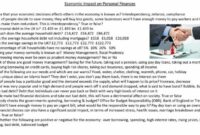Hidden costs of maintaining a luxury lifestyle go far beyond the initial purchase price. While the allure of opulent possessions and experiences is undeniable, the reality often involves a web of unexpected expenses that can significantly impact your finances. From the exorbitant maintenance of luxury vehicles and properties to the substantial costs of staffing, insurance, and security, the true price of a lavish lifestyle can be surprisingly steep.
This exploration delves into these often-overlooked financial burdens, revealing the hidden price tag associated with maintaining a life of luxury.
This article will examine the various facets of these hidden costs, providing concrete examples and data to illustrate the substantial financial commitment required. We’ll explore everything from the unexpected repairs on a superyacht to the complexities of employing a large household staff, shedding light on the often-unforeseen expenses that can quickly drain even the most substantial bank accounts. By understanding these hidden costs, individuals can make more informed decisions about their lifestyle choices and proactively manage their finances.
Unexpected Maintenance & Repair Costs
Maintaining a luxury lifestyle often comes with significant, and frequently unforeseen, expenses beyond the initial purchase price. These hidden costs can quickly escalate, impacting your budget and potentially straining your finances if not properly anticipated and planned for. Understanding these hidden expenses is crucial for responsible luxury living.
Luxury Vehicle Maintenance
The upkeep of luxury vehicles differs drastically from that of standard cars. Specialized parts, often sourced from overseas, command significantly higher prices. Furthermore, the complexity of these vehicles frequently leads to unexpected and costly repairs. For example, a simple sensor replacement in a luxury car could cost several times more than the equivalent repair in a standard vehicle.
This is due to the higher cost of parts, specialized tools, and often, higher labor rates for mechanics trained to work on these sophisticated machines.
| Part | Luxury Car Cost | Standard Car Cost | Cost Difference |
|---|---|---|---|
| Brake Pad Replacement | $800 – $1500 | $200 – $400 | $600 – $1100 |
| Engine Sensor Replacement | $500 – $1200 | $100 – $300 | $400 – $900 |
| Tire Replacement (Set) | $1500 – $3000 | $500 – $1000 | $1000 – $2000 |
| Major Engine Repair | $10,000 – $30,000+ | $3,000 – $8,000 | $7,000 – $22,000+ |
Luxury Home Maintenance
Owning a luxury home presents a unique set of maintenance challenges. Beyond the standard upkeep of a typical residence, luxury properties often incorporate sophisticated systems requiring specialized expertise and expensive repairs. Smart home technology, for example, can be incredibly convenient, but malfunctions can lead to significant repair bills. Similarly, pools, spas, and extensive landscaping add layers of complexity and ongoing costs.The high initial investment in a luxury home is often followed by substantial ongoing maintenance expenses.
Ignoring these costs can lead to costly damage and reduced property value.
- Smart home system failures (network issues, device malfunctions): These can require specialized technicians and potentially extensive rewiring.
- Pool and spa equipment repairs (pump failures, heater malfunctions): These systems require regular maintenance and can experience costly breakdowns.
- Extensive landscaping maintenance (irrigation system repairs, tree trimming): Maintaining expansive grounds demands significant resources.
- HVAC system failures (complex climate control systems in large homes): Repairs can be extensive and costly.
- Structural issues (foundation cracks, roof leaks): These can be particularly expensive to address in large, complex homes.
Luxury Watercraft and Aircraft Maintenance
The operational costs of luxury yachts and private jets far exceed those of more conventional transportation. Docking fees at exclusive marinas, specialized insurance premiums, and the salaries of crew members (for yachts) contribute significantly to the overall expense. Regular maintenance, including hull cleaning and engine servicing for yachts, and meticulous inspections and repairs for private jets, also represent substantial ongoing costs.
| Luxury Watercraft Type | Annual Operating Cost (Estimate) |
|---|---|
| Small Motor Yacht (under 50ft) | $50,000 – $150,000 |
| Large Motor Yacht (over 100ft) | $500,000 – $2,000,000+ |
| Sailing Yacht (over 70ft) | $100,000 – $500,000+ |
Staffing and Personnel Expenses: Hidden Costs Of Maintaining A Luxury Lifestyle

Source: idntimes.com
Maintaining a luxury lifestyle often involves a significant financial commitment beyond the cost of lavish homes and possessions. A crucial, and often overlooked, aspect is the substantial expense associated with employing household staff. These costs extend far beyond simply paying salaries; they encompass a complex web of benefits, potential legal liabilities, and unforeseen expenses. Understanding these hidden costs is crucial for realistic budget planning.
Household Staff Salaries and Benefits
Employing household staff, such as chefs, butlers, and drivers, adds a considerable layer of expense to a luxury lifestyle. Salaries alone represent a substantial outlay, but the associated costs of benefits and potential legal issues significantly inflate the overall financial burden. The following table illustrates a potential breakdown of these costs:
| Staff Role | Average Annual Salary | Benefits Costs (Estimated) | Potential Additional Expenses |
|---|---|---|---|
| Private Chef | $100,000 – $150,000 | $20,000 – $30,000 (Health insurance, paid time off, retirement contributions) | Professional liability insurance, specialized equipment, food costs |
| Butler | $75,000 – $120,000 | $15,000 – $25,000 (Health insurance, paid time off, retirement contributions) | Uniforms, travel expenses, professional development courses |
| Personal Driver | $50,000 – $80,000 | $10,000 – $15,000 (Health insurance, paid time off) | Vehicle maintenance, insurance, fuel costs |
Note: These salary and benefit figures are estimates and can vary significantly based on location, experience, and specific job requirements.
Unexpected Expenses Related to Household Staff
Managing a large household staff inevitably leads to unforeseen expenses. These hidden costs can significantly impact the overall budget.The following are five examples of unexpected expenses related to managing a large household staff:
- Staff Turnover and Recruitment Costs: Finding and hiring qualified staff is time-consuming and expensive. Advertising, background checks, and agency fees add up quickly.
- Legal Fees and Disputes: Employment-related disputes, such as wrongful termination lawsuits, can result in significant legal costs.
- Training and Development: Investing in staff training programs to ensure high-quality service can be a considerable expense.
- Accommodation and Meals: Providing on-site accommodation or meal allowances for live-in staff adds to the overall budget.
- Insurance Premiums: Comprehensive liability insurance to protect against potential accidents or damages caused by staff is essential.
Hiring Specialized Staff vs. Outsourcing
The decision of whether to hire specialized staff or outsource tasks is a crucial financial consideration. Both options have advantages and disadvantages.For instance, hiring a full-time gardener might cost $60,000 annually including salary and benefits. Outsourcing lawn care and garden maintenance, on the other hand, could cost $100-$200 per visit, depending on the size and complexity of the work.
Similarly, a full-time cleaning staff might cost $75,000 annually, while a cleaning service could charge $200-$400 per cleaning. The best option depends on the frequency of needed services and the overall budget. Consider the frequency and complexity of the tasks when making the decision.
Insurance and Security Costs
Maintaining a luxury lifestyle often involves substantial hidden costs beyond the initial purchase price of assets. Insurance and security represent a significant portion of these ongoing expenses, often exceeding the expectations of even the most financially prepared individuals. These costs are directly tied to the value and vulnerability of the assets and lifestyle being protected.Insurance premiums for high-value assets are considerably higher than those for standard items.
The cost is determined by a complex calculation involving the asset’s value, its risk profile (theft, damage, etc.), and the coverage level selected. For example, insuring a multi-million dollar home requires a far larger premium than insuring a modest property, and the same principle applies to valuable art collections, jewelry, and even luxury vehicles. These costs are not simply a percentage of the asset’s value; they often involve specialized policies and higher deductibles.
Insurance Costs for Luxury Assets
The table below illustrates how insurance costs can vary based on the value and type of asset. Note that these are illustrative examples and actual costs will vary based on location, insurer, and specific policy details. It’s crucial to obtain personalized quotes from reputable insurance providers specializing in high-net-worth individuals.
| Asset Type | Asset Value | Estimated Annual Premium |
|---|---|---|
| Luxury Home | $5,000,000 | $25,000 – $50,000 |
| Art Collection | $1,000,000 | $10,000 – $20,000 |
| Jewelry Collection | $500,000 | $5,000 – $10,000 |
| Luxury Vehicle Collection (3 vehicles) | $750,000 | $7,500 – $15,000 |
Advanced Security Systems and Measures
Protecting luxury properties and valuables necessitates sophisticated security systems and measures. The initial installation costs, coupled with ongoing maintenance and monitoring fees, can quickly accumulate. These costs are an investment in safeguarding valuable assets and ensuring peace of mind.
The following are five key security features and their associated costs:
- Integrated Security System: This includes alarm systems, motion detectors, and CCTV cameras. Installation costs can range from $10,000 to $50,000 or more depending on the complexity and scale of the system. Annual maintenance contracts typically add another $2,000 to $5,000.
- Perimeter Security: Fencing, gates, and lighting can significantly deter intruders. Costs vary widely depending on materials and property size, ranging from $5,000 to $100,000 or more.
- Access Control Systems: Keypads, biometric scanners, and security personnel control access to the property. Installation costs can range from $5,000 to $20,000, with ongoing maintenance fees.
- Safe Rooms and Vaults: For storing high-value items, secure rooms or vaults provide an additional layer of protection. Costs can range from $10,000 to well over $100,000 depending on size and security features.
- Security Monitoring Services: Professional monitoring services provide 24/7 surveillance and rapid response to alarms. Monthly fees can range from $500 to $2,000 or more depending on the level of service.
Personal Safety and Security Costs, Hidden costs of maintaining a luxury lifestyle
Protecting one’s personal safety is paramount, and the costs associated with this can be substantial. This includes private security details, travel security arrangements, and other protective measures. The cost structure varies significantly depending on the level of protection required.For example, a basic security detail might involve one or two off-duty police officers or private security guards for occasional events or short trips, costing around $50 to $100 per hour per guard.
A more comprehensive security detail for a high-profile individual might involve a team of armed guards, armored vehicles, and advanced surveillance, potentially costing tens of thousands of dollars per day or even more. International travel security requires specialized expertise and planning, adding further to the overall expense. The costs associated with personal safety are often unpredictable and depend heavily on the perceived threat level and the individual’s lifestyle.
Lifestyle Inflation and Hidden Spending
Maintaining a luxury lifestyle often involves a gradual but significant increase in spending, a phenomenon known as lifestyle inflation. This isn’t about conscious overspending; it’s the subtle creep of higher expenses that become normalized over time, making it difficult to track and control. Understanding these hidden costs is crucial for effectively managing a luxury budget.Lifestyle inflation subtly escalates expenses across various areas, primarily dining, travel, and entertainment.
Small upgrades in daily choices, seemingly insignificant at first, compound into substantial annual expenditures. For example, consistently choosing a more expensive restaurant or opting for first-class travel instead of economy can quickly drain a budget. Similarly, frequent high-end entertainment choices can significantly impact overall spending.
Examples of Accumulative Luxury Spending
The cumulative effect of seemingly small luxury purchases is often underestimated. Consider these everyday expenses: a daily artisanal coffee, a weekly manicure, monthly magazine subscriptions, or the occasional designer accessory. These individual costs may seem minimal, but their combined impact over time is substantial.
| Item | Frequency | Cost per Item | Annual Cost |
|---|---|---|---|
| Artisanal Coffee | Daily | $6 | $2190 |
| Manicure | Weekly | $50 | $2600 |
| Magazine Subscriptions | Monthly | $20 | $240 |
| Designer Accessory (occasional) | Quarterly | $500 | $2000 |
| Total Annual Cost | $7030 |
The table above illustrates how seemingly small luxury purchases can quickly accumulate to a significant annual expense. This doesn’t even include larger discretionary spending.
Insignificant Expenses with Significant Impact
Many seemingly insignificant expenses can rapidly escalate when maintaining a luxury lifestyle. These often go unnoticed until a thorough budget review is conducted.
- Membership Fees: Country club memberships, private gyms, and exclusive social clubs all come with substantial annual fees.
- Subscriptions: Streaming services, online publications, and premium app features can add up quickly.
- Personal Care: High-end skincare products, regular spa treatments, and personal trainers contribute significantly to overall expenses.
- Concierge Services: Utilizing concierge services for travel arrangements, event tickets, or personal errands adds a layer of convenience but at a considerable cost.
These seemingly small, regular expenses, when combined, contribute substantially to the overall cost of maintaining a luxurious lifestyle.
Cumulative Impact of Regular Luxury Expenses
Regular expenses associated with maintaining a luxury lifestyle, such as private jet travel or luxury car maintenance, significantly impact the overall budget. These costs, while seemingly manageable individually, accumulate rapidly over time. Imagine a bar graph. The X-axis represents the months of the year (Jan-Dec). The Y-axis represents the cost in dollars. Several bars represent different expenses: Private jet travel (showing significant spikes), luxury car maintenance (showing regular, moderate costs), high-end restaurant meals (showing irregular but high costs), and personal shopper fees (showing smaller, regular costs). The graph visually demonstrates how these individual costs, when combined, result in a dramatically high total annual expenditure. The total annual cost is significantly higher than the sum of the individual monthly costs, illustrating the compounding effect of these expenses.
Tax Implications and Legal Fees
Maintaining a luxury lifestyle often comes with significant and often unforeseen tax burdens and legal complexities. Understanding these costs is crucial for responsible financial planning and avoiding potential legal pitfalls. This section will delve into the intricacies of taxation and legal fees associated with high-value assets and the lifestyle they support.
Property Taxes
Property taxes on luxury homes, yachts, and private jets vary drastically depending on location. Jurisdictions with high property values tend to have higher tax rates. For instance, a mansion in Manhattan will incur significantly higher property taxes compared to a similar property in a rural area. These taxes are often levied annually and can represent a substantial portion of the overall cost of ownership.
Furthermore, luxury properties may be subject to additional assessments based on features like square footage, land size, and amenities.
Sales Taxes and Import Duties
The purchase of luxury goods and services is often subject to significant sales taxes, which can vary widely between states and countries. Import duties on luxury items purchased internationally add another layer of cost. For example, importing a high-end vehicle may incur substantial import tariffs and customs fees on top of the purchase price. These taxes can easily increase the overall cost by a significant percentage.
Inheritance Taxes and Estate Planning
Passing on significant wealth through inheritance can trigger substantial estate taxes, especially in jurisdictions with high tax brackets. Luxury assets, such as art collections, real estate, and valuable jewelry, are frequently included in estate valuations, significantly increasing the tax liability. Careful estate planning is essential to minimize these costs and ensure a smooth transfer of assets to heirs.
Tax Burden Comparison Across Jurisdictions
| Jurisdiction | Property Tax Rate (Example) | Sales Tax Rate (Example) | Inheritance Tax Rate (Example) |
|---|---|---|---|
| New York City, USA | 1-2% of assessed value (can be much higher depending on assessment) | 8.875% | 16% (for estates above a certain threshold) |
| London, UK | Variable, depending on property value and borough | 20% (VAT on many luxury goods) | 40% (for estates above a certain threshold) |
| Monaco | Relatively low | No VAT on many goods | No inheritance tax |
Note
These are examples and actual rates can vary significantly based on specific circumstances and individual assets. Consult with a tax professional for accurate information.
Potential Legal Fees
Managing the legal complexities of a luxury lifestyle can generate substantial legal fees. These costs can quickly escalate depending on the nature and complexity of the legal issue.
The following are examples of potential legal issues and associated costs:
- Estate planning and probate: Creating a comprehensive estate plan to minimize inheritance taxes and ensure a smooth transfer of assets can cost thousands of dollars. Contested probate proceedings can cost significantly more.
- Real estate transactions: Purchasing or selling high-value properties involves significant legal work, including contract review, due diligence, and title insurance, which can cost thousands of dollars.
- Dispute resolution: Disputes over ownership, contracts, or other legal matters relating to luxury assets can result in extensive legal fees, including litigation costs and attorney fees.
- Tax disputes: Challenging tax assessments or audits can incur substantial legal costs, especially if the matter goes to court.
- Intellectual property rights: Protecting the ownership and licensing of intellectual property associated with luxury assets can also involve significant legal fees.
Compliance and Regulatory Costs
Owning and operating luxury assets often involves navigating complex regulations and obtaining necessary permits and licenses. Failure to comply can result in significant fines and penalties.
Examples of compliance and regulatory costs include:
- Building permits for renovations or construction on luxury properties: Obtaining permits for significant renovations or construction on a luxury property can involve substantial fees and delays.
- Licenses for operating a yacht or private jet: Operating a yacht or private jet requires various licenses and certifications, incurring significant costs for training, examinations, and ongoing maintenance.
- Environmental permits for luxury developments: Luxury developments, particularly those located in environmentally sensitive areas, may require extensive environmental impact assessments and permits, leading to considerable expenses.
- Import and export licenses for luxury goods: Importing or exporting luxury goods may necessitate specific licenses and permits, subject to varying fees and regulations depending on the item and country.
Closing Notes
Maintaining a luxury lifestyle, while undeniably appealing, demands a thorough understanding of its often-hidden financial implications. From the seemingly small, everyday expenses that accumulate rapidly to the substantial costs associated with maintaining high-value assets and employing extensive staff, the true cost can far exceed initial expectations. By acknowledging these hidden expenses and proactively budgeting for them, individuals can enjoy the benefits of a luxurious lifestyle while mitigating the risk of unforeseen financial strain.
Ultimately, informed financial planning is crucial to navigating the complexities and ensuring long-term financial stability.
Helpful Answers
What are some common hidden costs associated with luxury travel?
Hidden costs in luxury travel can include things like excessive baggage fees, expensive airport lounge access, unexpected visa or passport fees, and unforeseen costs related to last-minute itinerary changes or travel insurance.
How can I mitigate the risk of unexpected repair costs on a luxury car?
Regular preventative maintenance is key. A good service contract can also help offset unexpected repair costs. Choosing a reliable brand with a good service history can also reduce the likelihood of major issues.
What are some ways to reduce staffing costs in a large household?
Consider outsourcing certain tasks, like cleaning or gardening, instead of hiring full-time staff. Negotiating salaries and benefits packages can also help reduce overall costs. Careful staff selection to minimize turnover is also crucial.
How do property taxes on luxury homes compare to those on standard homes?
Property taxes on luxury homes are generally significantly higher due to the higher assessed value of the property. The exact difference varies greatly depending on location and local tax laws.
What are some strategies for managing lifestyle inflation?
Regularly review spending habits and identify areas where expenses can be reduced. Set a realistic budget and stick to it. Consider tracking expenses using budgeting apps or spreadsheets to gain a clearer picture of spending patterns.




